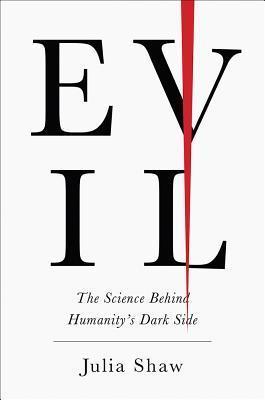
Dr. Julia Shaw explores the definition of evil in her book Evil: The Science Behind Humanity’s Dark Side. Her hypothesis states that there is no such thing as evil as a measurable character trait, for which she provides a compelling argument. Dr. Shaw goes about methodically presenting her case, looking first at people labeled as evil by history and then moving on to actions people typically describe as evil. Throughout each page, she maintains her compassion and neutrality, neither condemning nor condoning any socially unacceptable behavior. It all makes for a fascinating read.
Dr. Shaw devotes the first few chapters to physiology, highlighting studies that examined the brains of sociopaths and serial killers to prove her point that there is no physiological smoking gun when it comes to determining whether one can consider a person evil. There are some differences in the brain for sociopaths, but, as she is careful to mention, being a sociopath does not mean that one will commit a crime or act in a deviant manner. Her collection of findings makes you pause as you realize the implications of what Dr. Shaw is saying – in essence, there is no such thing as an evil person. It means that men like Hitler, Stalin, and Pol Pot are not evil per se. Their ideas may be despicable, and their actions were deplorable, but they themselves were not inherently evil.
Before you get a chance to process that idea, Dr. Shaw moves on to what society deems as evil behavior, which includes everything from serial murder, pedophilia, rape, animal love, and more. In each example, Dr. Shaw is careful to reiterate her hypothesis that there is no such thing as an evil person no matter what the crime. She argues that it is a person’s mental state which determines the deviancy of the behavior. A pedophile is not evil but mentally unhealthy and in desperate need of coping mechanisms and psychological help to overcome his or her urges. Someone who loves animals – in both spiritual and physical ways – is someone who needs help establishing healthy relationships with humans. Rape is about control, as is murder to some extent. In both cases, the person committing the crime needs help learning to control his or her emotions and finding healthy outlets for the rage. Dr. Shaw pushes all buttons in this section, tackling the most taboo of behaviors and not pointing blame at anything other than society’s inability to provide the help mentally disturbed people need.
She closes her argument with the idea that if we can look beyond the offensive behavior and look to the person behind the action, only then can we, as a society, help these people get the help they need. Evil doesn’t exist, but people who are mentally ill do, and it is when we can look to the person where we can change how we treat such behaviors and best help society. Again, it is a premise that requires a lot of contemplation to consider in its entirety, but the studies Dr. Shaw cites provides evidence that is difficult to ignore.
Evil is not an easy book to read. The behaviors Dr. Shaw explores are behaviors most people would never consider, and learning about them is a disconcerting, out-of-body experience as you grapple to understand how people can think and act in such a fashion. That reaction, though, is Dr. Shaw’s point. She wants us to think about this; she wants to challenge our social norms so that we can see that a pedophile typically recognizes their emotions and reactions towards children are not how one should feel. She wants us to understand what it means when a person would rather fall in love with an animal than a human. She wants us to recognize that incarceration for such crimes does not help anyone – it does not benefit society, and it most certainly does not support the perpetrator. In the end, she realizes that she might not be able to convince everyone of her hypothesis, and she accepts that. It is my belief, however, that everyone who reads Evil finishes the novel with a greater awareness that she may have a point so that the next time someone mentions that there may be a sexual predator living in your neighborhood, you will remember what she said and pause your condemnation. If Dr. Shaw is right, then that pause may be the start of a dialog that could change everything. Or not.
